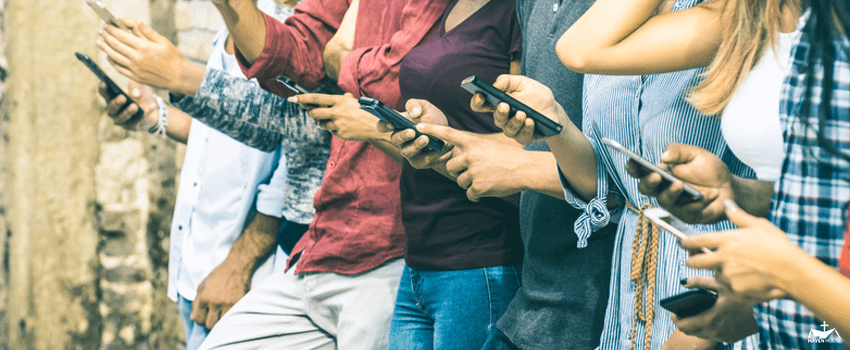

Social media has altered how we interact with the world. They have changed how we interact with politicians, get information, establish connections, and make decisions. The impact has been magnified for individuals growing up with access to social media.
How does social media affect teenagers’ mental, emotional, and physical well-being? In particular, how has teens’ social media usage affected their substance use, especially drug and alcohol use?
It is critical for parents, guardians, instructors, and youth to understand how social media might influence teen substance use. Today, we will examine the impact of social media and drugs on teens in recent decades.
How Many Teenagers Are Active on Social Media?
Social media is undeniably influential in teen culture. But how many teenagers use it? According to the American Academy of Child and Adolescent Psychiatry, 90 percent of teenagers have used social media, with 51 percent using it at least once daily. It equates to 37.8 million teenagers using social media.
Furthermore, Pew Research Center statistics from 2018 show:
- 95% of teenagers have access to a smartphone, and 45% claim they are online “on a near-constant basis.” Social media platforms are among the most popular ways for kids to interact with online information.
- YouTube (used by 85% of all US adolescents), Instagram (72%), and Snapchat are the most popular social media sites (69%)
- Snapchat (35% use it more than any other platform), YouTube (32%), and Instagram are the platforms most often used by US youths (15%)
How Much Time Do Teenagers Devote to Social Media?
Individuals’ social media habits differ widely. Nevertheless, teens spend an average of 9 hours a day watching entertainment media. Girls spend one hour and 32 minutes on social media, while guys spend 52 minutes. Extrapolated, this indicates that teenage females spend around 10 hours and 44 minutes each week on social media, while males spend approximately 6 hours and 7 minutes. This amounts to 23.3 days and 13.2 days each year, respectively.
Teens spend the most time on Snapchat and YouTube. Indeed, YouTube outperforms every other content platform. Teens watch 37% of their daily video streaming time on YouTube and 35% on Netflix. The statistics constitute a significant time commitment on the part of teens. This begs the issue of what they see on YouTube and how it’s influencing their conduct, from drug use in teens to cyberbullying.
The Influence of Social Media on Adolescents and Young Adults
The teenage years are a time of fast development for an individual, and the physical, social, and emotional changes accompanying puberty may be a sensitive and stressful time in life. While social media can provide new channels for self-expression, sociability, and amusement for teenagers, it can also complicate their life by:
- Distracting kids from maintaining real-world social bonds or academic work
- Sleep disruption due to late-night consumption
- Reinforcing unreasonable expectations of oneself and others;
- Increasing unpleasant emotions like anxiety, dread, or despair (particularly in posts about negative news or in vitriolic social interactions). This may lead to the development of mental health problems in adolescents.
- Putting kids in danger of oversharing, which might result in sensitive or personal photographs or tales becoming part of a user’s digital footprint
- exposing children to the possibility of cyberbullying
- exposing children to social media peer pressure on substance usage
The last of them is a concern shared by many teenagers. According to the previously mentioned Pew Research Center research, 13% of youth feel that social media influences young users to succumb to peer pressure. But, can social media have this kind of effect on teenagers?
Is Social Media a Factor in Drug Use in Teens?
For many decades, many teenagers have been interested in drug experimentation. However, teens in the current society have access to a tremendous source of exposure and peer pressure to participate in dangerous substance use, unlike previous generations. While social media cannot directly induce kids to experiment with drugs or alcohol, it may be a powerful motivation for them to do so.
While overall drug usage in America is increasing, teen substance use is decreasing yearly. This statistic may seem significant; still, adults must be mindful of how exposure to social media may encourage adolescents to develop problematic substance-use habits. However, why do teenagers use drugs in the first place?
Why Do Teenagers Use Drugs
Friends and relatives
Friends and family are the most influential people in a young person’s life. Seeing these loved ones engage in drug or alcohol use online can significantly influence a teen’s tendency to make the same, normalizing consumption patterns and to break down stigmas associated with substance use.
Teens can form deep relationships with their peers. With the ubiquity of social media in today’s environment, these ties may become a constant source of peer pressure in the lives of youngsters. Teens may alter their conduct to “fit in” with their peers. They may even engage in self-destructive conduct, such as excessive alcohol consumption. If family members actively participate in substance use on social media or at home, the behavior may become more normalized.
Social media can alter perceptions of harmful substances and increase risk-taking in situations where a youngster would not otherwise be enticed. Social media may be manipulated to present only the “positive,” creating a false sense of safety or glamorization.
Influencers and celebrities
Celebrities and other significant influencers generate a large portion of the content that teenagers and young adults connect with on social media. Teens may be tempted to emulate this content if it models and normalizes drug use problems. The breadth of the problem is described in this article from the National Institute on Drug Abuse for Teens:
“(Many celebrities) utilize their celebrity and status to promote their drinking and drug usage.” Wiz Khalifa, Diplo, Rihanna, and Nicki Minaj have all uploaded hundreds of images, including drugs and alcohol. More than 7% of Snoop Dogg’s Instagram photos contain drugs or alcohol. A basic search for the hashtag #marijuana yields over 2.8 million results.”
This deluge of material might be hazardous to teenagers and young adults. Young people may be tempted to experiment with narcotics after seeing them glamorized online.
Increased Accessibility
Young people may be enticed to contact drug traffickers via social media due to the aforementioned societal pressures – a risky notion for various reasons. Social media platforms facilitate communication with people from all walks of life. As a result, kids can utilize social media to get drugs and alcohol. Many platforms ban users from selling narcotics using their services. However, creating additional user accounts to support such transactions is simple and may sustain drug use in teens.
Key Takeaway
It might be upsetting to learn that a teen in your life has started using illicit substances such as marijuana, other drugs, or alcohol. It is critical at this point to go above your own emotions, examine the issue logically, and discuss the matter with the adolescent in a constructive manner. It is critical to have an open and good connection with teenagers to gain their trust. This increases the likelihood that, if they are inclined to try substance usage, they will talk to you before making a mistake.
Getting Help is Important
With social media becoming more intertwined into today’s kids’ life, what they see on these sites is more critical than ever.
The best method to safeguard your children from these influences is to communicate openly with them and educate them on the dangers of substance misuse. However, if your child is battling excessive alcohol or drug use, merely talking to them may not be enough, and professional treatment may be required. If you are concerned about the direction your teen is taking, reach out to Haven House Recovery’s center of addiction recovery in Santa Rosa Beach, FL, for treatment options regarding social media and drugs.
You, like our present, previous, and prospective customers, are not alone in your battle with addiction. Contact us right away!
Newsletter Signup
Discipleship Training
“The teaching of the wise is a Fountain of Life, turning a person from the snares of death.”
Proverbs 13:14 NIV


